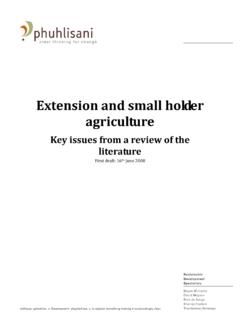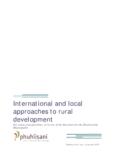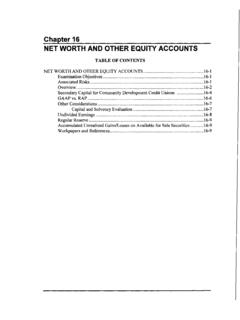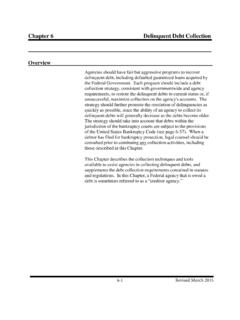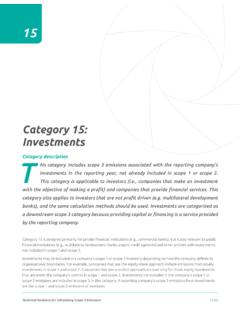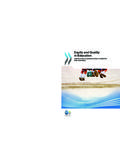Transcription of Chapter 1: Introduction to the livelihoods framework
1 Introduction to the livelihoods framework1 Chapter 1:Introductionto the livelihoodsframework provides a basic Introduction to the livelihoods framework . Aftercomparing the basic features of various livelihoods models in use, it describes the main features ofthe livelihoods approach, and what its strengths and its weaknesses are. It then explores how theapproach can be put into practice through appreciative enquiry and participatory problem analysis. Thechapter ends with answers to a number of questions which might be asked by programme chapter2 Learning about livelihoodsUnderstanding the terminologyTo navigate your way through this book, you will need to understand a fewbasic terms and concepts.
2 In particular you need to be clear about thedifference between a conceptual framework and a methodological framework is a particular way of viewing the world .1 The livelihoodsframework is a way of understanding how households derive their liveli-hoods by drawing on capabilities and assets to develop livelihoodstrategies composed of a range of framework defines and categorises the differenttypes of assets and entitlements which householdshave access to. The framework examines the differ-ent factors in the local and wider environment thatinfluence household livelihood security.
3 The frameworklooks at the connections between the local or micro situationand actors, institutions and processes at work in the wider with a framework requires understanding its different elements andthe connections between them. Because people view the world in differentways and theorise the relations between things differently, frameworks areconstantly contested, adapted and refined. Even where people agree onfundamental core concepts, they may use different terms to describe may emphasise different elements, or think about the interactionsbetween the elements in different ways.
4 In this book we use a model thatuses common livelihoods number of variations of the basic livelihoods framework have been de-scribed by different development actors. They use different terms to de-scribe similar things. Sometimes the language or concepts are so complexthat only academics and policy developers are likely to use them. In thisbook we have tried to simply explain the core components of livelihoodsframeworks. We have tried to create a bridge between different livelihoodsmodels and the thinking about how to put livelihoods analysis into can be argued that the livelihoods framework does not require participa-tory or appreciative planning approaches to put it into practice.
5 Others likeDiana Carney2 say that the framework is built on a participatory authors of this book place a high value on participatory research andplanning methods,3 appreciative enquiry and participatory problem analysisas appropriate tools to examine different aspects of the framework . Theprecise mix of tools and methods used to investigate elements of the liveli-hoods framework will vary from practitioner to practitioner and situation to the livelihoods framework3 The concept of sustainable livelihoodsThe concept of sustainable livelihoods is a reference point for a wide rangeof people involved in different aspects of development policy formulationand planning.
6 As analysts point out, there are two broad approaches todefining livelihoods . One has a narrower economic focus on production,employment and household income. The other:takes a more holistic view which unites concepts of economicdevelopment, reduced vulnerability and environmentalsustainability while building on the strengths of the rural livelihoods concepts and methodological approaches in this book arerooted in this more holistic view. The livelihoods framework is not restricted toanalysing rural livelihoods . It has important applications in understanding urbanlivelihoods and vulnerability and the linkages between rural and urban there are differences of interpretation and different variations ofthe livelihoods framework , they all build on earlier development include aspects of the integrated rural development planning (IRDP)approaches of the 1970s;5 food security initiatives during the 1980s; rapidrural appraisal (RRA); participatory rural appraisal (PRA); farming systemsresearch; gender analysis; new understandings of poverty and well-being.
7 Risk and vulnerability assessment; and agrarian earlier development approaches assumed that rural society washomogenous (in other words, that there was no differentiation betweenhouseholds in rural areas) and that households had single-purpose econo-mies (in other words, that they only had one way of making a living). As aresult, development agencies tended to focus on narrow, sectoral, produc-tion-orientated strategies that often bypassed those most at risk and failed torecognise that poor households have multiple economic One ofthe key findings that flowed from participatory research and appraisal was amuch more subtle understanding of livelihoods and the different elementsthat they work of Chambers and Conway in the early 1990s built on participa-tory research practices and ideas put forward by the World Commission onEnvironment and Development.
8 They developed a definition of livelihoodsand the factors that make them sustainable which underpins all of thelivelihoods frameworks currently being used:A livelihood comprises the capabilities, assets (stores, resources,claims and access) and activities required for a means of living:a livelihood is sustainable which can cope with and recoverfrom stress and shocks, maintain and enhance its capabilitiesand assets, and provide sustainable livelihood opportunities for the4 Learning about livelihoodsnext generation; and which contributes net benefits to other liveli-hoods at the local and global levels in the long and short Chambers and Conway definition was modified by DFID in 1999, adefinition that is widely used:A livelihood comprises the capabilities, assets (including bothmaterial and social resources) and activities required for ameans of living.
9 A livelihood is sustainable when it can copewith and recover from shocks and stresses and maintain andenhance its capabilities and assets both now and in the future,whilst not undermining the natural resource livelihoods definitions make people more central and are less con-cerned with precise terminology for different kinds of assets. They highlightissues of ownership, access and decision making. One of these definitionsof livelihoods states:People s capacity to generate and maintain their means ofliving, enhance their well-being and that of future capacities are contingent upon the availability and acces-sibility of options which are ecological, economic and politicaland which are predicated on equity , ownership of resources andparticipatory decision differences in emphasis by different practitioners, the livelihoodsframework helps us to.
10 Identify (and value) what people are already doing to cope with risk anduncertainty make the connections between factors that constrain or enhance theirlivelihoods on the one hand, and policies and institutions in the widerenvironment identify measures that can strengthen assets, enhance capabilities andreduce frameworks compared10 The DFID frameworkOne of the most widely used frameworks is the one used by the UK Depart-ment for International DFID framework sets out to conceptualise: Introduction to the livelihoods framework5 how people operate within a vulnerability context that is shaped bydifferent factors shifting seasonal constraints (and opportunities), eco-nomic shocks and longer-term trends how they draw on different types of livelihood assets or capital in differ-ent combinations which are influenced by.
